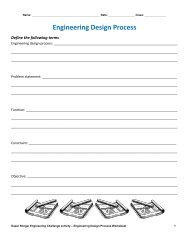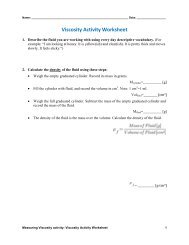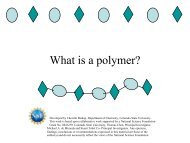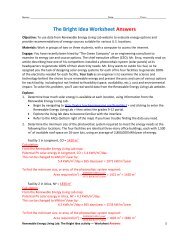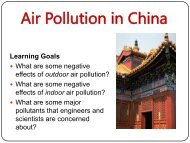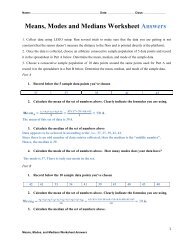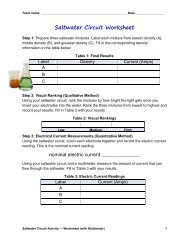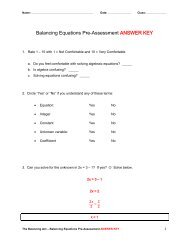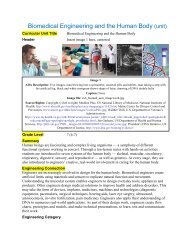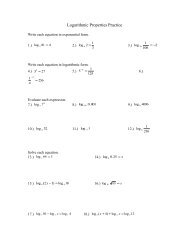Groundwater Pollution Worksheet Answers (pdf) - Teach Engineering
Groundwater Pollution Worksheet Answers (pdf) - Teach Engineering
Groundwater Pollution Worksheet Answers (pdf) - Teach Engineering
You also want an ePaper? Increase the reach of your titles
YUMPU automatically turns print PDFs into web optimized ePapers that Google loves.
Name: _____________________________________<br />
Date: ________________________<br />
ANSWER KEY<br />
<strong>Groundwater</strong> <strong>Pollution</strong> <strong>Worksheet</strong><br />
PART 1<br />
1. Find the pH at each sample site. Label the concentration as high (H), low (L) or none(N).<br />
Draw the direction of the contaminated groundwater flow on the diagram.<br />
Sample #<br />
pH<br />
Concentration<br />
(H, L or N)<br />
1 N<br />
2 N<br />
3 H<br />
4 L<br />
5 L<br />
6 L<br />
2. Why might the groundwater flow in that direction<br />
<strong>Answers</strong> will vary. The plume spreads in the direction of the groundwater. There is probably<br />
a hill or higher elevations on the left side of the map. Another reason might include the type<br />
of soil/substrate — such as high concentrations of clay on the left side of the map.<br />
Environmental <strong>Engineering</strong>: Lesson 4, <strong>Groundwater</strong> Detectives Activity –<br />
<strong>Groundwater</strong> <strong>Pollution</strong> <strong>Worksheet</strong> Answer Key 1
Name: _____________________________________<br />
Date: ________________________<br />
Now, we are going to predict how fast it will take for the contaminant to reach Community A<br />
using the diagram below. You will need a ruler.<br />
3. First, soil samples were taken at site #4 over one year. On the 10 th month, a rise in the<br />
level of contaminants was found. Find the velocity of the contaminant at sample site #4.<br />
Remember, Velocity (v) = distance (D) ÷ time (t).<br />
D (measured with rule)r = 1.25 inch or 30m<br />
t = 10 months<br />
v = D ÷ t<br />
v = 30 ÷ 10<br />
v = 3.0 m/month<br />
4. Next, we need to find the area of a cross-section of the contaminant plume at site #4<br />
(shown by the dotted line). Remember Area (A) = width (w) x depth (d). We know that<br />
the groundwater is 1 meter in depth.<br />
w (measured with a ruler) = 1.25 inches or 30 m<br />
d = 1 m<br />
A = w x d<br />
A = 30 x 1<br />
A = 30 m 2<br />
5. We use the cross section of the area we just found to calculate the Flow (Q) of the<br />
groundwater over the whole area. Flow (Q) = Area (A) x velocity (v).<br />
A (from #4) = 30 m 2<br />
v (from #3) = 3.0 m/month<br />
Q = A x v<br />
Q = 30 x 3.0<br />
Q = 90 m 3 /month<br />
Environmental <strong>Engineering</strong>: Lesson 4, <strong>Groundwater</strong> Detectives Activity –<br />
<strong>Groundwater</strong> <strong>Pollution</strong> <strong>Worksheet</strong> Answer Key 2
Name: _____________________________________<br />
Date: ________________________<br />
6. Next, we need to find the area of a cross-section of the plume at community A (shown by<br />
the dotted line). Remember Area (A) = width (w) x depth (d). We know that the<br />
groundwater is 1 meter in depth.<br />
w (measured with a ruler) = 2.25 inches or 90 m<br />
d = 1 m<br />
A = w x d<br />
A = 90 x 1<br />
A = 90 m 2<br />
7. Then, we use our flow (Q) from above (assuming the flow is constant) to find the<br />
velocity of the contaminant at community A. We rearrange our flow equation to read<br />
Velocity (v) = Flow (Q) ÷Area (A).<br />
Q (from #5) = 90 m 3 /month<br />
A (from #6) = 90 m 2<br />
v = Q ÷ A<br />
v = 90 ÷ 90<br />
v = 1.0 m/month<br />
8. Lastly, we rearrange our velocity equation to solve for the amount of time for the<br />
contaminant to reach Community A. Our equation now reads time (t) = distance (D) ÷<br />
velocity (v).<br />
D (measured with ruler) = 2.5 inches or 100m<br />
v (from #7) = 1.0 m/month<br />
t = D ÷ v<br />
t = 100 ÷ 1.0<br />
t = 100 months<br />
9. Write your prediction for the time it will take the contaminated groundwater to reach<br />
Community A.<br />
I predict the contaminated groundwater will reach the community is 100 months or 8 1/3<br />
years.<br />
Circle the groundwater treatment method you would choose for this site. <strong>Answers</strong> will vary.<br />
Treatment Name Description Time<br />
Containment<br />
(Physical barriers)<br />
Biological treatment<br />
Chemical treatment<br />
Soil vapor extraction<br />
Pump and treat<br />
Placing something in the ground to stop the<br />
groundwater flow.<br />
Adding microorganisms like bacteria that eat<br />
the contaminant to make it less toxic.<br />
Adding chemicals like that react with the<br />
contaminant to make it less toxic.<br />
Moving air and vapors through the groundwater in<br />
order to remove the contaminant.<br />
Pumping the contaminated water out of the<br />
ground, treat the water and put it back into the<br />
ground.<br />
1 year<br />
10+ years<br />
6 months-3<br />
years<br />
3-5 years<br />
5-10 years<br />
Environmental <strong>Engineering</strong>: Lesson 4, <strong>Groundwater</strong> Detectives Activity –<br />
<strong>Groundwater</strong> <strong>Pollution</strong> <strong>Worksheet</strong> Answer Key 3
Name: _____________________________________<br />
Date: ________________________<br />
PART 2: Remediation (ANSWERS TO PART 2 WILL VARY)<br />
1. Using the available tools for water treatment, brainstorm combinations to get your water<br />
sample clean. Make a list of your ideas. Be specific.<br />
2. Pick one treatment combination from your above list to test. This is your treatment<br />
process. Which treatment process did your group choose and why<br />
3. Test your treatment process and write your observations here.<br />
4. Was your treatment process effective Why or why not<br />
5. What improvements would you make to your treatment process<br />
6. Test your modified treatment process from #5 and write your observations here.<br />
Environmental <strong>Engineering</strong>: Lesson 4, <strong>Groundwater</strong> Detectives Activity –<br />
<strong>Groundwater</strong> <strong>Pollution</strong> <strong>Worksheet</strong> Answer Key 4
Name: _____________________________________<br />
Date: ________________________<br />
7. Was your second process more effective than your first process<br />
8. What recommendations would you make for treatment of this contaminated water<br />
9. What constraints did you consider when you designed your treatment process (Cost,<br />
environmental effects, time, etc.)<br />
Environmental <strong>Engineering</strong>: Lesson 4, <strong>Groundwater</strong> Detectives Activity –<br />
<strong>Groundwater</strong> <strong>Pollution</strong> <strong>Worksheet</strong> Answer Key 5



